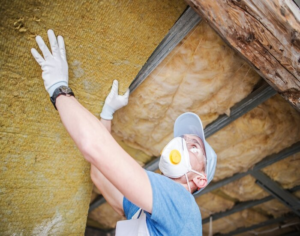The air that circulates through your home or business is filtered through ductwork. When this ductwork becomes dirty, it needs cleaning.

Agitation and reverse pressure vacuuming are essential steps in the process. Avoid companies that recommend spraying chemical biocides or sealants inside your ducts without fully understanding the pros and cons. Contact Duct Cleaning Salt Lake City for professional guidance.
1. Improved Airflow
Dirty ducts cause your heating and cooling system to work harder than it should, which results in higher energy bills. Duct cleaning helps reduce these costs by allowing your HVAC equipment to function properly.
Over time, air ducts become dirty with the accumulation of dust, dirt, animal dander, skin cells and more. This material is pulled into the air conditioning system, recirculated and then blown out through the vents in your home.
As a result, dusty air is circulated throughout the house and can cause allergic reactions in people who suffer from severe allergies or asthma. Even if you do not have any respiratory conditions, circulating this dust and dirt can cause itchy, watery eyes, itching of the nose and throat, sinus congestion and bronchial coughing. Clean ducts prevent these pollutants from being circulated and help everyone in your home breathe easier.
The National Air Duct Cleaning Association (NADCA) recommends that you have your ductwork cleaned every three to five years. However, if you have pets or live in an area with high levels of pollution or if someone in your family has a chronic health condition such as asthma, it may be necessary to do the job more often.
During a duct cleaning, the technician sweeps the inside of your vents and ductwork, then uses negative pressure to suck up all the debris. He or she also inspects the ductwork for signs of mold, mildew or pest infestation. In some cases, a moisture sensor or infrared camera may be used to check for these issues. To prepare for a duct cleaning, make sure all the vents are easy to access and that any animals or children are not in the way of the service technician.
2. Improved Indoor Air Quality
Duct cleaning enhances your indoor air quality by removing the build-up of contaminants. Dirty ducts can harbor mold, mildew, and other bacteria that can trigger respiratory issues and allergic reactions. The agitating power of a specialized cleaning tool is used to remove the debris from the interior surfaces of your ducts, after which a truck-powered vacuum cleans the entire system. This eliminates the potential for mold and mildew, as well as dander from pets, odors from cigarettes or cooking, and other contaminants from circulation in your home’s air.
By eliminating airborne particles, duct cleaning significantly improves your breathing habits and promotes a healthier lifestyle. Breathing fresh, uncontaminated air enables you to focus and perform at your best. Duct cleaning also reduces irritants that can cause allergies and respiratory discomfort, allowing you to sleep better at night and enjoy a sense of well-being upon waking up.
When ductwork is dirty, it is the perfect breeding ground for rodents and other pests. The unpleasant odors generated by these pests can then be circulated throughout your home. Regular duct cleaning eliminates these conditions, as well as the rodent droppings that they leave behind.
While studies have shown that duct cleaning may help to minimize some respiratory problems, it has not been proven that it prevents health problems or lowers energy costs. In addition, the duct cleaning process is not without its risks, and it can actually impede air flow and damage your HVAC equipment. Therefore, it is important to hire a certified technician to perform the job and make sure that your heating and cooling equipment is not damaged during the procedure. This is especially true if you have young children or pets at home during the time of the duct cleaning appointment.
3. Increased Energy Efficiency
Many energy-saving strategies focus on appliances, insulation, and other measures, but air duct cleaning is an often overlooked way to reduce your home’s energy consumption. Clean ducts maintain optimal airflow dynamics, allowing your HVAC system to operate more efficiently. Regular duct cleaning also helps control microbial growth, which can affect system efficiency.
Dirty ducts increase your energy consumption because they force your system to work harder to heat or cool your home. Clogged air ducts cause your HVAC unit to overwork and use more energy to compensate, leading to increased power bills and a higher carbon footprint.
Duct cleaning involves the use of specialized tools to dislodge dust, dirt, and other contaminants from duct surfaces. Then, they are vacuumed away with high-powered equipment. Air ducts collect particles and pollutants throughout the year, but they only become airborne if disturbed. Many professionals recommend duct cleaning at least every five years to keep the ventilation system clear.
Some sources of airborne contaminants may require duct cleaning on an even more frequent basis. For example, pet dander can build up in the vents and create an optimal breeding ground for bacteria and fungus. Also, if you’ve recently built or remodeled your house, construction debris can contaminate the ductwork and circulate in your living spaces.
Rodents can also take up residence in ductwork, chewing through the vents and leaving behind signs like chewed materials and droppings. These pests introduce fecal particles into the air, which can contaminate your indoor air and lead to health problems. Regular duct cleaning can help eliminate the risk of rodent infestations. It’s important to hire a qualified technician to ensure the process is completed safely and effectively.
4. Reduced Indoor Air Pollution
The accumulated pollutants in air ducts can be a source of health risks. Air duct cleaning eliminates these sources, improving indoor air quality (IAQ). In addition to the obvious benefits of improved health, cleaner air also contributes to increased productivity. The circulating clean air enhances focus and alertness, leading to better performance at work or home.
Ventilation duct cleaning reduces the accumulation of dust, dirt, pet dander, pollen, mildew, and other contaminants in the ventilation system. These contaminants are a major cause of respiratory problems in people with allergies and asthma. In addition, duct cleaning reduces unpleasant odors caused by these contaminants and helps prevent pest infestations, including rodents and insects that can introduce harmful pathogens into the indoor air.
Air duct cleaning has been shown to reduce the concentration of some indoor air pollutants, such as volatile organic compounds and bacterial contaminants. However, the positive impact of duct cleaning on other air pollutants has yet to be proven.
Duct cleaning is a cost-effective way to improve indoor air quality. When performed regularly, it can reduce allergy and asthma symptoms, reduce the occurrence of other breathing problems, and help maintain optimal energy efficiency. However, homeowners should not rely solely on this method to improve IAQ in their homes; it is important to take other steps as well. These other steps include:
5. Reduced Allergens
Several types of allergens can cause itchy eyes, runny nose, coughing, wheezing, and other respiratory symptoms. These allergens are often released into the air by household pets, mold spores, mildew, dust mites, and pest droppings. Duct cleaning significantly reduces these allergens in the home. This helps people breathe easier and live happier, healthier lives.
Dust mites are microscopic creatures that thrive in warm and humid environments. When they settle in ductwork, they release their fecal matter and body fragments into the air. These allergens can cause a wide variety of allergy symptoms, including rashes, itchiness, and asthma attacks. During duct cleaning, professionals thoroughly clean and sanitize ductwork, vents, and HVAC components, preventing dust mites from releasing their irritants into living spaces.
Allergens like pet dander, mold spores, and mildew can also build up in ductwork, causing irritation when they are circulated. Duct cleaning eliminates these allergens, making it easier for families to enjoy the company of their furry friends without suffering constant allergy symptoms.
Pest droppings can also build up in ductwork, and when the HVAC system circulates them, they can trigger respiratory problems and allergies. During the duct cleaning process, technicians thoroughly inspect and sanitize ductwork, removing hard-to-remove rodent droppings.
Smoke particles can also enter ductwork and contaminate the HVAC system, irritating respiratory systems and causing unpleasant odors in homes. Professional duct cleaning helps remove lingering smoke particles and prevents them from recirculating, improving indoor air quality for everyone.








